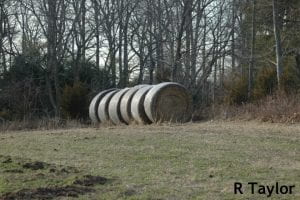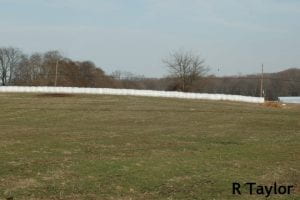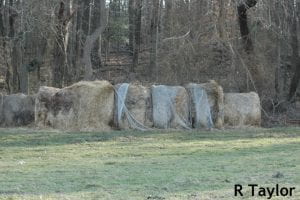Richard Taylor, Extension Agronomist; rtaylor@udel.edu
On my way to work each day, I drive by a dairy farm and often enjoy watching all the activities occurring on the farm. The thing that has struck me in particular over the years is not just how much hay has been stored along field borders and roadways and around the barnyard in the fall; but how much of that hay remained the next year and beyond (Photos 1, 2 and 3). I watched as the oldest round bales stored on the wood line gradually decayed and disappeared. This was caused in part due to on-ground storage that allowed moisture to wick into the bale (Photo 3). Being somewhat dense (on occasion), it took me a long time before I realized that he was actually cutting hay for quantity rather than for quality; I guess the grower had in mind that some of the low quality hay could be used in the TMR feed as a fiber source while the remainder could be fed to dry cows or heifers if feed ran short.
Photo 1. Hay (6 months post harvest) stored in round bales along wood’s edge on a dairy farm. This hay although in contact with the soil was stored at the top of a hill but the quality was declining and the amount of spoiled hay was rapidly increasing.
Photo 2. Hay from previous years’ harvest stored along field edge on a dairy farm. Wrapped in this fashion, soil moisture was not causing spoilage although wildlife damaging the plastic was contributing to hay losses. Late in the spring this hay was actually fed to the herd.
Photo 3. Hay stored in contact with the ground along a wood’s edge deteriorates with time. At another location with twine wrapped bales, I was too late to even find recognizable bales.
The next question that came to mind was whether cutting hay for quantity rather than quality is the correct way to manage this valuable resource when year after year more old hay is added to the fence line compost line. With diesel prices at or near four dollars per gallon at the pump, nitrogen and other fertilizer inputs near all time highs, and hay equipment and supplies also very expensive, producers need to place a higher value on the hay they do harvest. For dairy producers, the cost of importing feed onto the farm is another consideration when deciding whether to harvest hay for quality or quantity. That extra effort to harvest hay for quality rather than quantity can really pay premium dollars in reduced input costs and, if you sell hay, in the price you can charge customers.
Still there will be times when there’s a mismatch between the weather and the forecast that results in poor quality hay lying in the field and to preserve the health of the grass or legume stand the hay must be removed. Other times, a long period of poor hay-making weather will result in an overly mature hay crop. In these cases, you may end up with “fence-row” hay. One thing you can do in these situations is to minimize your hay making inputs by using the simplest, least expensive method of removing the hay from the field. If it’s still good enough, use this hay for animals with minimal nutritional requirements or advertize and sell it as mulch or compost hay. Creative marketing may just help you cover at least a portion of the input costs incurred.



